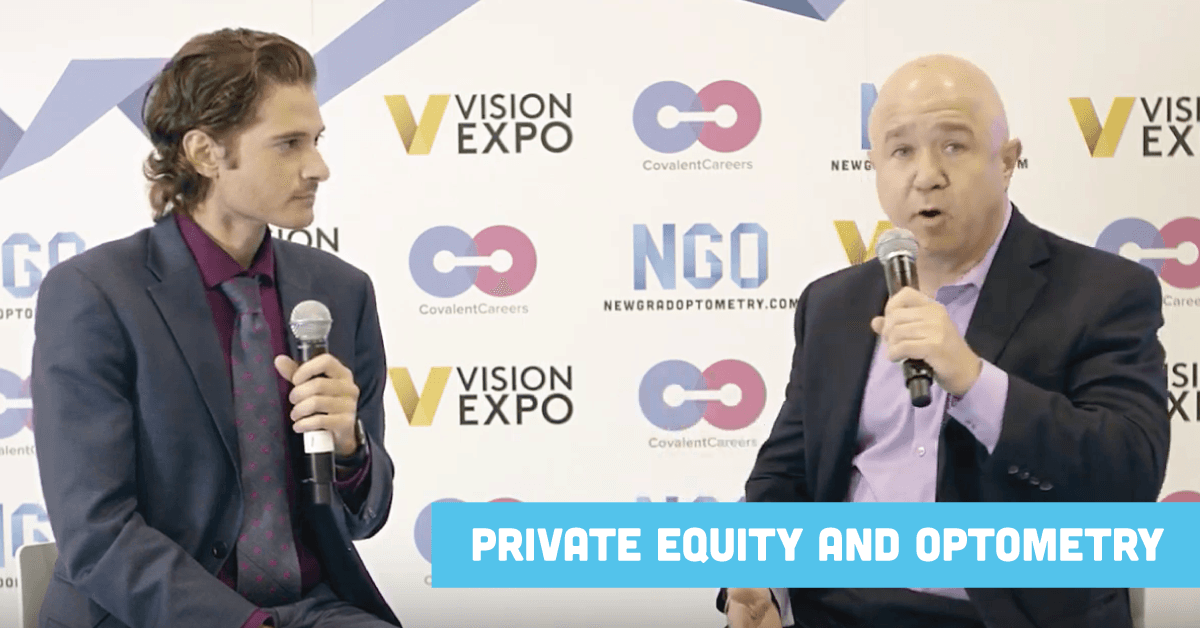Dr. Alan Glazier, OD, FAAO, DIPL ABO and Dr. Antonio Chirumbolo, OD chat at Vision Expo West 2018 to discuss the growing relationship between private equity and the eyecare industry.
How do you start the process?
Dr. Glazier, when presented with the opportunity to sell his practice, was forced to reflect on the practice’s performance. It was only through this process that he realized the business was underperforming relative to the rest of the industry. He used this opportunity to pay more mind to the business side of the practice and identified places that he could improve.
Perhaps the idea of selling your practice is still years away. You can still take actions today to prepare and build toward that. While each private equity firm will have a different model for how they approach acquiring a practice, some of these requirements overlap such as groups that are looking for practices that are in a “financial sweet spot.” There is some variability, however, from group to group as some may be interested in young, growing practices around the $500,000 mark, others in more mature businesses nearer to a $1m valuation.
While some PE groups will “come in and do a housecleaning,” others will leave existing teams in place if the practice is already operating well.
If you’re a practice owner and are considering selling your practice, you should take the time to consider what you would like your role to be post-sale as well. If your goal is to return exclusively to the exam lane, that’s great, but you can also consider a partial-management role. Be sure to include these wants in your sale negotiation so that you can arrive at a deal that works best for your goals. Keep in mind, your position won’t be the only one affected! What about your team?
What do private equity groups do?
Thankfully, it's in the firm’s best interest to continue to build and develop your practice and your employees. If there are doctors already in place, the firm can craft a new deal with the existing physicians that is similar to their existing contract. Other staff members can be a different story. While some PE groups will “come in and do a housecleaning,” others will leave existing teams in place if the practice is already operating well.
The practice will continue to evolve under new ownership which will likely mean rebranding and acquiring new technology, but that’s not always the case. Dr. Glazier joined with Total Eyecare which recognized his existing brand equity and opted to keep it in place. A change in brand may affect patient retention or comfortability which could ultimately hurt the practice more than it helps it.
Is private equity good for optometry?
As private equity groups continue to expand, there is a great deal of discussion around whether or not this kind of expansion is good for the industry. Dr. Glazier is excited to see the development of the industry. Practice groups are creating more opportunities for ODs looking for work and allowing them to grow in ways that smaller practices may not have been able to afford, so they are able to then attract younger ODs more frequently.
Once a practice is acquired, the ideal for the PE group is to grow it and sell it in five to ten years with profit margins greater than those that were in place when they bought into the business. It is then passed along a chain of owners and companies as it morphs and evolves to incorporate the beliefs and ideas of the new business owners. There does have to be some level of congruence between the businesses themselves as well.
Some more retail-focused groups may not mesh well with more medically-oriented practices. In order to prepare for these transitions, some practices may “back into a deal” by developing resources that their next buyer may find appealing when they are ready to sell. An example of this may be better implementing medical treatment and billing in a clinic that is not currently doing any (or is doing very little) medical work.
Have you discovered your love for practice management? Your next step might be getting your MBA! Here’s our Ultimate Guide to the MBA for ODs.
Focusing too much on the business side of a practice can raise flags for some healthcare professionals. "If the practice becomes all about profits and growth, my patients and their quality of care could be jeopardized!" But this isn't always the case. Dr. Glazier believes that his practice is in good hands, and ultimately, if a patient decides they are not receiving what they are looking for from you, they may go elsewhere, and that’s okay. The decision to sell was, for him, a great experience and has helped him to take care of his family, and he's sure his patients will be alright.
With all of these elements considered, the onboarding and selling process can take anywhere from three months to six months for PE groups that have effective systems in place. Dr. Glazier’s experience of a year-long process was a unique one, but it is also important to consider that holdups may occur in the pipeline of a sale. Selling your business to a PE firm (or to anyone for that matter) isn't an easy decision, but if you are considering it, be sure to examine the process carefully.
